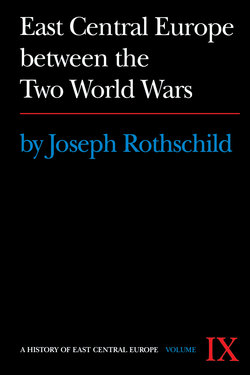Читать книгу East Central Europe between the Two World Wars - Joseph Rothschild - Страница 9
На сайте Литреса книга снята с продажи.
ОглавлениеFOREWORD
THE systematic study of the history of East Central Europe outside the region itself began only in the last generation or two. For the most part historians in the region have preferred to write about the past of only their own countries. Hitherto no comprehensive history of the area as a whole has appeared in any language.
This series was conceived as a means of providing the scholar who does not specialize in East Central European history and the student who is considering such specialization with an introduction to the subject and a survey of knowledge deriving from previous publications. In some cases it has been necessary to carry out new research simply to be able to survey certain topics and periods. Common objectives and the procedures appropriate to attain them have been discussed by the authors of the individual volumes and by the coeditors. It is hoped that a certain commensurability will be the result, so that the eleven volumes will constitute a unit and not merely an assemblage of writings. However, matters of interpretation and point of view have remained entirely the responsibility of the individual authors.
No volume deals with a single country. The aim has been to identify geographical or political units that were significant during the period in question, rather than to interpret the past in accordance with latter-day sentiments or aspirations.
The limits of “East Central Europe,” for the purposes of this series, are the eastern linguistic frontier of German- and Italian-speaking peoples on the west, and the political borders of Rus/Russia/the USSR on the east. Those limits are not precise, even within the period covered by any given volume of the series. The appropriateness of including the Finns, Estonians, Latvians, Lithuanians, Belorussians, and Ukrainians was considered, and it was decided not to attempt to cover them systematically, though they appear repeatedly in these books. Treated in depth are the Poles, Czecho-Slovaks, Hungarians, Romanians, Yugoslav peoples, Albanians, Bulgarians, and Greeks.
There has been an effort to apportion attention equitably among regions and periods. Three volumes deal with the area north of the Danube-Sava line, three with the area south of it, and four with both areas. Four treat premodern history, six modern times. The eleventh consists of a historical atlas and a bibliography of the entire subject. Each volume is supplied with a bibliographical essay of its own, but we all have attempted to keep the scholarly apparatus at a minimum in order to make the text of the volumes more readable and accessible to the broader audience sought.
The coeditors wish to express their thanks to the Ford Foundation for the financial support it gave this venture, and to the Institute of Comparative and Foreign Area Studies (formerly Far Eastern and Russian Institute) and its three successive directors, George E. Taylor, George M. Beckmann, and Herbert J. Ellison, under whose encouragement the project has moved close to being realized.
The whole undertaking has been longer in the making than originally planned. Two of the original list of projected authors died before they could finish their volumes and have been replaced. Volumes of the series are being published as the manuscripts are received. We hope that the usefulness of the series justifies the long agony of its conception and birth, that it will increase knowledge of and interest in the rich past and the many-sided present of East Central Europe among those everywhere who read English, and that it will serve to stimulate further study and research on the numerous aspects of this area’s history that still await scholarly investigators.
PETER F. SUGAR
DONALD W. TREADGOLD
Seattle
